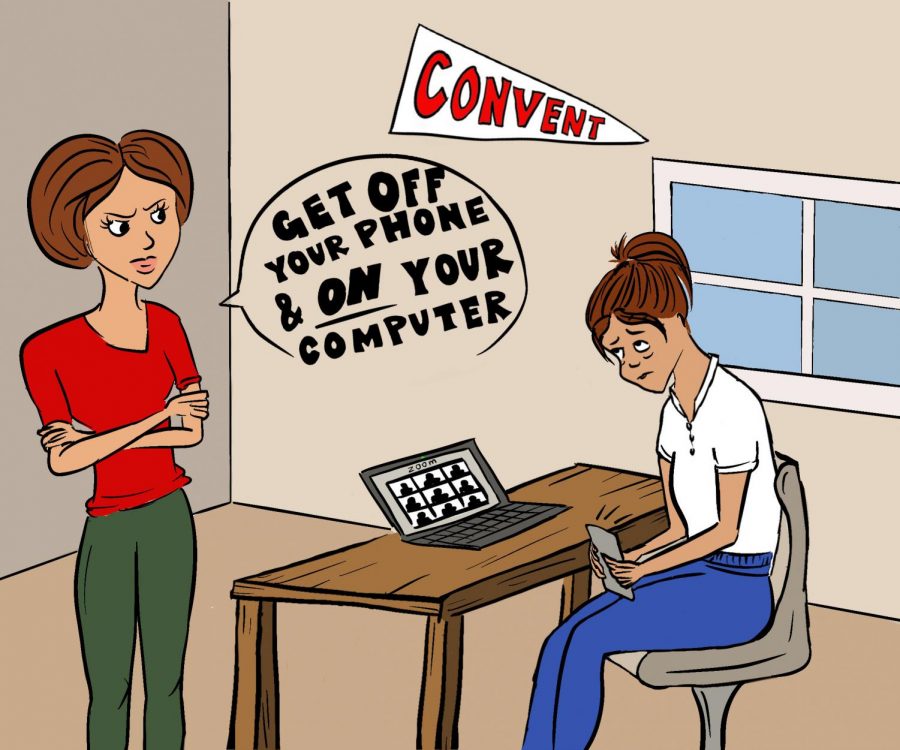Zooming towards a certain doom
Virtual learning taxes students’ mental and physical health
Virtual learning settings take a toll on students’ mental and physical health.
September 24, 2020
Most teenagers who find themselves a little too attached to their phone or computer, or even ones who just thoroughly enjoy the company of their family’s TV, have heard some variation of these sentences from the guardians in their lives: “You’re on social media too much. You watch Netflix too much. You FaceTime and text too much. Screen time is turning your brain into mush.”
Now, the very technology that is “turning our brains into mush” has become a mandatory part of our daily lives as online learning takes center stage in the education world.
Convent & Stuart Hall’s new block schedule was strategically and thoughtfully designed to minimize contact between larger groups of students should classes resume in person on campus, but when transferred to a virtual learning system, this schedule becomes extremely draining, making online learning much more difficult.
With campus remaining closed, most students tune in to at least two 2 ½-hour classes on the videotelephony software, Zoom, every day with minimal breaks. A much needed 1 ½-hour lunch break takes place in between each class, but even this time for a potential screen detox is interrupted by a rotation of assemblies, chapels, advisories and clubs.
The American Academy of Pediatrics (AAP) recommends that teens place limits on the use of any technology or media. Whether it be entertainment or education as the effects of too much screen time can be detrimental to both students’ mental and physical health.
The AAP also suggests that children have two hours or less of non-moving screentime per day as a sedentary lifestyle has direct links to obesity. This is about three hours less than the length of a typical virtual school day for students at Convent & Stuart Hall.
A stationary lifestyle can lead to depression in adolescents, according to a study reported in The Lancet Psychiatry. Every hour of idle behavior per day at the ages of 14 and 16 was found to have a relation to an increase in the total score of depressive symptoms by 8% and 10.5%, respectively.
And the negative effects don’t stop there. Blue light created by screens can influence melatonin levels and disturb sleep which, in turn, can impact the way that students focus and perform in school. The very tools which students are using to obtain their education are in turn hindering their overall wellbeing.
Students need longer or more frequent breaks during their class periods and assignments should be curated to minimize the use of screens— perhaps with physical pens and paper— when possible. In addition, a fully Zoom-free lunch period is a must in order to combat these technology-induced side effects.
After sitting all day and staring at a screen, time for physical activity is critical for students. This can be hard to achieve when homework and extracurriculars need attending to — especially since even these now require screens to participate in.
Walking from the bedroom to the kitchen for lunch is not enough daily exercise to sustain a healthy lifestyle. While most students may not have time to maintain a rigorous two-hour-per-day workout schedule, they need to feel empowered to make time for moderate outdoor activity without feeling like they are robbing time from class, homework or extracurriculars.
Physical activity improves cognitive function, reduces the risk of anxiety and depression, and improves sleep and quality of life, according to the CDC. With all of the positive side effects, it is imperative that students are able to make time to stay active during their daily life and away from their screens.
Balance is key for a healthy and manageable lifestyle, and right now, students are feeling as though the scales are tipping towards certain Zoom Doom.











Briac Poilane • Sep 24, 2020 at 11:12 pm
A very well articulated and insightful article. The references to health studies solidifies the point of view. As a student myself I would have to agree that classes of this length are extremely draining and can certainly have an impact on students mental and physical wellbeing. Having a routine that includes some form of daily exercise is very important. Even taking a 10-20 minute walk around the block or at your nearest park can provide relief and a much needed break from our screens. Enjoyed the article Tabitha.